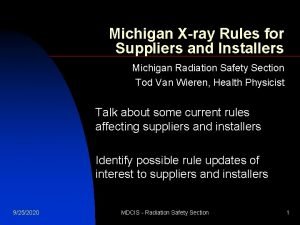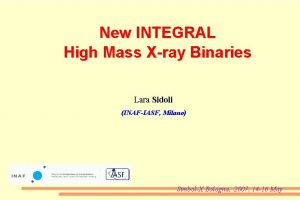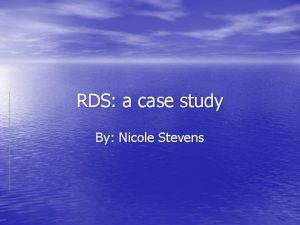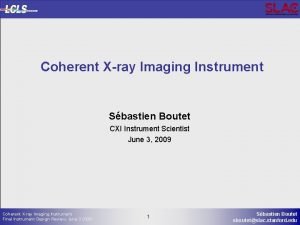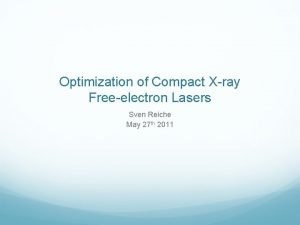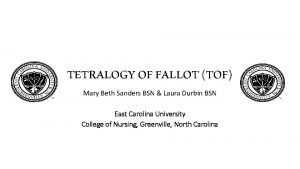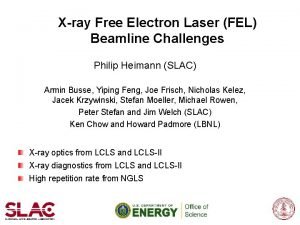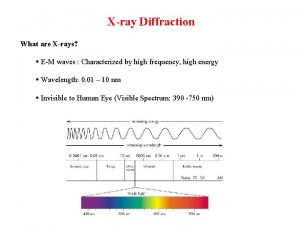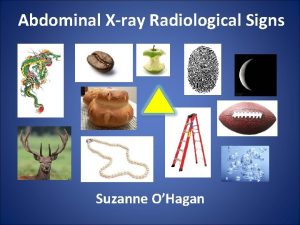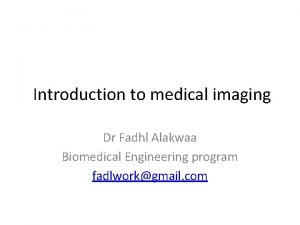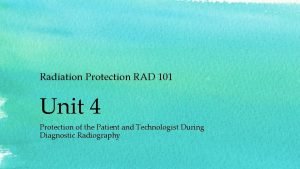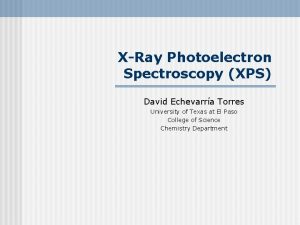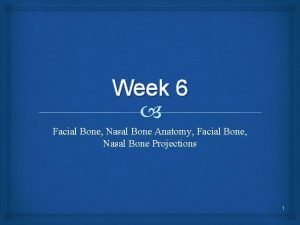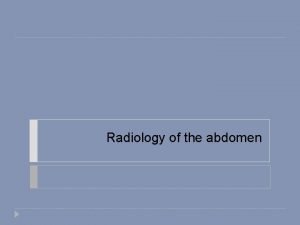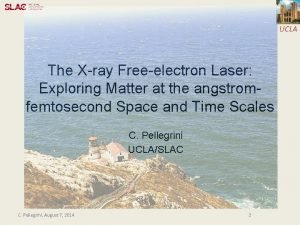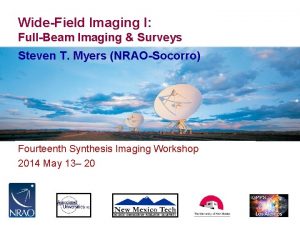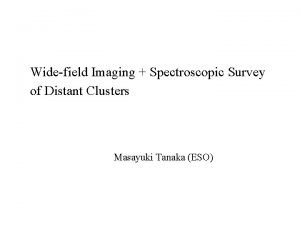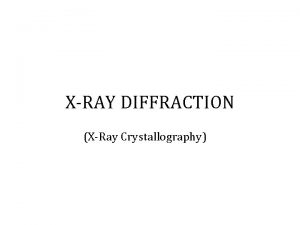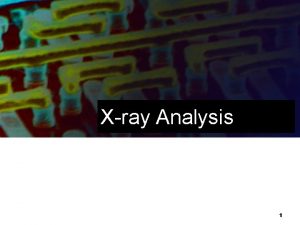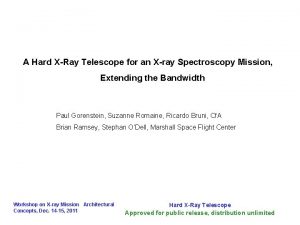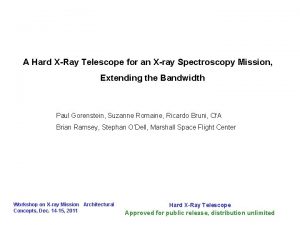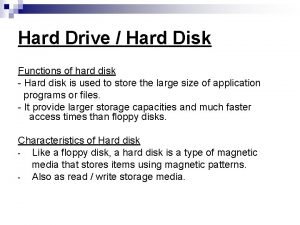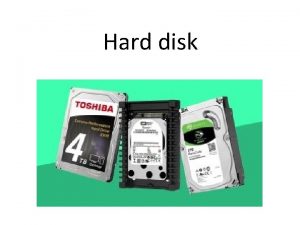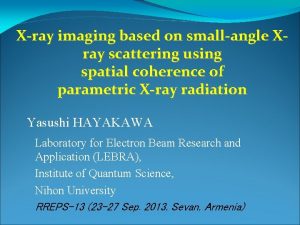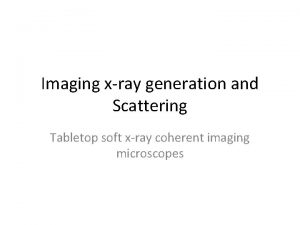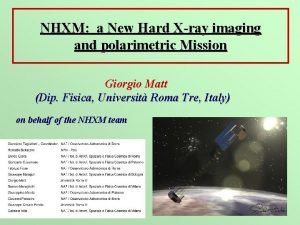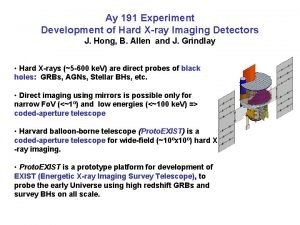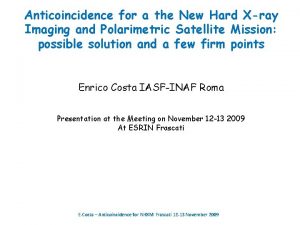An Ultimate Widefield Hard Xray Imaging Survey Proposed




















- Slides: 20

An Ultimate Wide-field Hard X-ray Imaging Survey Proposed to EXIST Energetic X-ray Imaging Survey Telescope Surveying the universe in space and time for Black Holes Josh Grindlay Harvard And EXIST Concept Study Team members at: Harvard-SAO, Caltech, Columbia, Livermore, NASA/GSFC/MSFC, Stanford/SLAC, UC Berkeley/San Diego/Santa Barbara/Santa Cruz, Washington Univ. , Yale, Sonoma State, Ball Aerospace, Spectrum Astro, Cambridge/UK, CESR/Fr, Rome/It EXIST - 1 EXIST

Energetic X-ray Imaging Survey Telescope (EXIST) Hard X-ray (~5 -600 ke. V) all-sky imaging each orbit to measure: • Obscured AGN vs. z and accretion (BHs) vs. nuclear (stars) luminosity of universe • First (Pop. III) stellar Black Holes producing Gamma Ray Bursts (GRBs) EXIST measures properties of BHs, e. g. Cen-A, every orbit: characteristic time variability (QPOs) constrain BH mass and spin. Reference Design Mission parameters: • Extend ROSAT sens. (~0. 05 m. Crab) to >100 ke. V: 8 m 2 imaging (1. 2 mm pixels) CZT • All-sky imaging (5’ resolution; ~10 -50” positions): 3 coded aperture telescopes http: EXIST. gsfc. nasa. gov EXIST - 2 EXIST

Primary Science Questions for EXIST will address fundamental questions about black holes: - When and how were the first stellar black holes formed? - What is the epoch of obscuration of massive black holes? - How are dormant black holes revealed by stellar disruption? - How many stellar BHs and IMBHs in the Local Group? Survey will provide large samples of BHs from all sky survey with duty cycle for each object of ~20 -40% for unprecedented Spatial-Temporal Survey for BH populations. EXIST opens new discovery space: ~100 X faster full-sky imaging than previously or planned at any wavelength EXIST - 3 EXIST

EXIST Science Objectives: Details Survey BHs for obscuration and accretion luminosity Supermassive BH survey (Lx ~1044 erg/s to z ~1) IMBH survey in Local Group (ULX sources: spectra, QPOs) Stellar BH inventory in Galaxy (BHs in galactic bulge cusp; transients) BH Evolution Type 2 QSOs (z ~5 for most luminous) Accretion vs. stellar luminosity of universe (Lx vs. NH; Blazars) First (Pop III) BHs at z~15? (GRBs) Approaching BH event horizons Stars tidally disrupted by BHs (~10 -30 HX flares/year if ~1% Laccr in HX) Spectra and QPOs of BHs (thermal accr. vs. non-thermal jets) Secondary science Supernova rate in Galaxy from full galactic disk Ti-44 survey Planck scale physics from GRB timing Pulsars: neutron star B fields from cyclotron lines Magnetars out to Virgo cluster! Novae (511 ke. V survey) EXIST - 4 EXIST

Science Drivers for a Black Hole Finder • • Most massive black holes are thought to exist in obscured regions at centers of galaxies Obscured BHs likely outnumber all known BHs in AGN and in Galaxy Þ The best way to discover and study obscured BHs is by surveying the sky in the hard x-ray band Obscured Line of Site to Central Black Hole Emission Strongest in Hard X-ray Band EXIST - 5 EXIST

Key EXIST science: Obscured AGN ASCA and Beppo. SAX and now Chandra and XMM find likely dominant contribution of absorbed AGN (z ≤ 1) to cosmic x-ray background: EXIST survey SAX/PDS Swift NGC 1068 NGC 6240 HEAO (Vignati et al 99) Chandra deep surveys find Type 2 QSOs and XMM deep survey of Lockman Hole finds most still unresolved XRB is from obscured AGN EXIST will find >1 -3 obscured AGN/square degree and obtain first all-sky measure of Seyfert 2 QSO 2 luminosity function and constrain obscuration vs. z for supermassive BHs. EXIST - 6

Extragalactic Timing with EXIST First all-sky (every 95 min) imaging and variability survey at any energy • QPOs from BHs: EXIST detects ~3001000 AGN with FHX ≥ 2 m. Crab and timescales ~1 h -1 y, constrain BH Mass & spin parameter a/M • Tidal disruption of stars spiralling into Dormant SMBHs with mass ~107 Mo: if 1% of Lacc in HX band, EXIST may see ~10 -30 flares/yr out to ~100 Mpc! (Grindlay 2004). Will measure population of 106 -7 Mo dormant BHs in galaxy bulges! QPO (& 3: 2 resonance) vs. BH mass and a/M (Abramowicz, Kluzniak et al 2004) Sub-giants with WD cores are LISA gravitational wave triggers. Artists conception of tidal disruption of star in RXJ 1242 -1119 detected with ROSAT (1991) and confirmed with Chandra (Komossa et al 2004). EXIST - 7 EXIST

Key Science: GRBs probe stellar BHs at z~5 -20 • “Long”-GRBs are from SNIb, c and probable stellar BH formation • Likely very first stars were ~100 Mo and collapse to BHs GRBs! EXIST could detect many GRBs to z~20 and probe Pop. III stars: first BHs at re-ionization epoch suggested by WMAP and probe IGM. Photometric z from lum-lag And/or lum-Epeak correlations Flux vs. detected Epeak for GRBs from z=1 (top +) to 10 (bottom +) for Epeak =30, 100, 300, 1000 ke. V if emitted at z=1 vs. sensitivities (Band 2004). EXIST - 8 Response to E>100 ke. V needed even for z~10! EXIST

Key Science: Blazars, BHs-Jets & Cosmic Diffuse IR EXIST provides broad-band imaging and monitoring of all AGN classes, including Blazars. Hard x-ray (synchrotron) spectral breaks (~10200 ke. V) allow gamma-ray (~10 Ge. V - 10 Te. V) spectral breaks measured by GLAST and VERITAS to constrain origin of diffuse IR background for Blazars at known redshift (gamma-rays pair-produce on the IR background photons). Time-variable spectral breaks required from simultaneous HX measurements. Probe of non-thermal jet-disk interaction EXIST GLAST VERITAS SSC model for Mkn 501 (Coppi & Aharonian 1999) EXIST will provide the continuous HX spectral-monitoring to study Blazars and non-thermal AGN to constrain diffuse IR (~10 -100μ) background from obscured AGN and nuclear vs. accretion luminosity of the universe EXIST - 9

Stellar BHs and IMBHs in Local Group • All bright stellar BHs in transients (Lx(>10 ke. V) ~1038 erg/s) detected throughout Galaxy, LMC/SMC and M 31. Population of obscured binaries found with INTEGRAL: discrete, not diffuse, sources at >20 ke. V • Isolated stellar BHs in Galaxy and IMBHs in Local Group accreting via Bondi-Hoyle (with ~10 -4 efficiency) from GMCs nearly Compton thick • BHs in Galactic Bulge nuclear cusp (cf. Alexander & Livio 2004) detected if Lx(>10 ke. V) ≥ 1035 erg/s as expected for wind-fed binaries or for CI Cam type outbursts (~1 -2 d) Chandra view of central Bulge (~ 2 o x 1 o) EXIST - 10 EXIST

EXIST Mission Reference Design Free-Flyer (500 km, i ~ 22º): • Zenith pointer (Survey mode) • 3 -axis pointer (Observatory and survey) • 3 coded aperture telescopes (2. 7 m 2 area & 60º x 75º each) for 8 m 2 & 180º x 75º fan-beam: full sky/orbit & >20% continuous coverage Mission Parameters: • CZT tiled arrays: 8 m² total area, (20 x 5 mm crystals, ea. with 16 x 16 pixels; 5 x 106 pixels!) pixels Nod direction, ┴ scan (+/-20 o ea. ~10 min) scan direction (orbit veloc. vector) • Passive and active shielding; 50º x 60º collimation/module • Mass, power, telemetry: 8500 kg, 1400 W, 1. 5 Mbs (X-band) • Delta-IV launch EXIST - 11 EXIST

EXIST detectors and sensitivity • Detector is tiled Cd-Zn-Te (CZT) array: 20 x 5 mm, 16 x 16 pixels direct-bonded to low noise ASIC • Detector modules (DMs): 4 x 4 CZT detectors per board-µProc. 8 x 8 DMs per sub-telescope (ST); actively collimated 50 o x 60 o 3 x 3 or 4 x 4 STs per Telescope Cutaway view of EXIST detectors in one telescope. • 3 coded aperture Telescopes (2. 7 m 2 ea. ) 1. 5 m focal length, 2. 5 mm mask pix 5 arcmin resol. , 10 -50” loc. 0. 05 m. Crab = 5 x 10 -13 cgs, 5σ, 6 -9 mo, 20 -40% duty cyc. EXIST sensitivities. EXIST - 12 EXIST

Reference Design Detectors, Telescopes & Launcher Detector & active-collimator & Telescope-structure views (3 Telescopes + S/C: Ht x Diam ~8. 6 m x 4. 7 m) EXIST - 13 EXIST (revealed) in Delta-IV shroud EXIST

Requirements to achieve ~0. 05 m. Crab sensitivity • Very large detector area, Atot. ~8 m 2, and long exposure time, Texp since S/N ~ (Atot • Texp/B)1/2 for given background, B • Very large field of view, , in scan direction & need to scan since Texp ~ /(d /dt) for given orbital scan rate, d /dt, and scan needed to average over detector pixel-pixel variations (pixel-pixel systematics and background variations for N x N coded mask: reduce systematic noise sys by scanning source image(s) across ~2 N x 2 N detector pixels) • Imaging and mask design should yield 102 -3 dynamic range since any instantaneous FOV will have 1 source @ 5 -50 m. Crab (N. B. “coding noise” systematics for N x N coded aperture (non-URA): sys ~1/N, and further reduced by factor ~1/m 0. 5 for scan across m masks) Simulations show scanning greatly reduces systematics; Optimum scan strategies under study: scan + nod? EXIST - 14 EXIST

Simulated 3 C 273 field (scanning vs. pointing) 3 C 273 simulation: simulation 0. 5 - 1 year survey EXIST image (0. 05 m. Crab, 5 , 22 o Fo. V ). Scanning (left) vs. pointing (right), with 10% systematics (Grindlay and Hong 2003, SPIE) EXIST - 15 EXIST

EXIST technology development Imaging and detector technology development • Coded aperture hard x-ray imaging –Developed on SR&T/balloon payloads (e. g. EXITE) –Demonstrated in space on SIGMA, INTEGRAL • Cd-Zn-Te (CZT) detectors –Backgrounds measured & CZT imagers for balloons –Large-area (0. 5 m²) CZT array to be flown on Swift (2004) –Medical & Security imaging lowering CZT costs ($50/cm 2) EXITE coded aperture telescope (20 -600 ke. V) in balloon gondola • CZT imagers for 10 -600 ke. V: 64 cm² prototype, image & Ba-133 spectra CZT 3 prototype imager EXIST - 16 60 ke. V image lines at 276, 302, 356, 383 ke. V EXIST

Current EXIST technology develoment • CZT contacting and materials uniformity studies - Leakage current results follow for Imarad CZT with In vs. Pt contacts • ASIC development: - optimum depth sensing for >200 ke. V imaging and large Fo. V projection Δx to image plane: both cathode PHA and anode timing? Δx d Low power: <100µW per channel - sparse readout (peak pixel + neighbors, for optimum energy resolution and polarization sensitivity for GRBs, Blazars and non-thermal jets: Polarization from azimuthal direction of single Compton scattered photons (probable at E >200 ke. V) in 5 mm thick CZT. Image shown is GEANT simulation for 300 ke. V photons with polarization at 45 o as recorded by 0. 8 mm pixels • CZT detector-ASIC coupling and tiling - EXIST - 17 next generation ASIC and prototype interface ready for testing EXIST

Trade studies on EXIST design (partial list) • Energy range: 10 -600 ke. V vs. 5 -600 ke. V or 5 -300 ke. V? (single band) Or 5 -100 ke. V (LE) and 100 -600 ke. V (HE)? • Field of view: uniform ~5 sr vs. segmented in narrow (LE) and wide (HE)? • Angular resolution: 5 arcmin vs. ~30 arcsec (LE) and ~10 arcmin (HE)? • Shielding and active collimation: full or partial? partial • Calibration and on-board data processing/distribution EXIST - 18 EXIST

Alternative Telescope and Field of View Designs Two telescope version of Reference Design EXIST - 19 Alternative fields of view and sky coverage EXIST

EXIST as BH Finder Probe: Summary • EXIST conducts high priority science – Highest sensitivity full-sky probe of obscured BHs in universe – Ultimate sensitivity broad-band, high resolution study of GRBs at z~ 15 as probes of Pop. III stars/stellar BHs and reionization epochs – Decadal Survey high ranking shows broad astrophysics interest • EXIST well suited as BH Finder Probe – Hard X-ray/All-sky imaging-monitoring provides most complete and unambiguous BH survey and followup study – Synergy with GLAST, Nu. STAR, Con-X, JWST, JDEM and LSST – Technology and mission concept could support a 2011 launch • Concept Study can demonstrate mission viability – Detailed simulations & design trade studies to optimize science – Mission technology relatively understood; primary needs are CZT production, ASICs, imaging design, and digital processing EXIST - 20 EXIST
 Frc control system
Frc control system 意識abcd
意識abcd Hard times hard drive
Hard times hard drive What makes hard water hard lab investigation 3 answers
What makes hard water hard lab investigation 3 answers Have fun work hard make history
Have fun work hard make history Mdcis
Mdcis Xray lara
Xray lara Rds case study
Rds case study Picker xray
Picker xray Xray laser
Xray laser Mary beth sanders
Mary beth sanders Xray laser
Xray laser Xray waves examples
Xray waves examples Air under diaphragm
Air under diaphragm Fadhl alakwaa
Fadhl alakwaa Xray technique chart
Xray technique chart Xps instrument
Xps instrument Reverse waters method
Reverse waters method Pneumobilia adalah
Pneumobilia adalah Xray laser
Xray laser Xray xml editor
Xray xml editor





